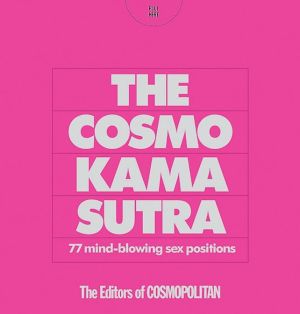The Art of Seduction
This bold, instructive guide to power of attraction by the bestselling author of The 48 Laws of Power, The 33 Strategies of War, and Mastery can make anyone a master of this devastating and timeless art\ This mesmerizing exploration of the most subtle, elusive, and effective form of power is a masterful analysis of civilization's greatest seducers, from Cleopatra to JFK, as well as the classic literature of seduction from Freud to Kierkegaard and Ovid to Casanova. Robert Greene once again...
Search in google:
This mesmerizing exploration of the most subtle, elusive, and effective form of power is a masterful analysis of civilization's greatest seducers, from Cleopatra to JFK, as well as the classic literature of seduction from Freud to Kierkegaard and Ovid to Casanova. Robert Greene once again identifies the rules of a timeless, amoral game and explores how to cast a spell, break down resistance, and, ultimately, compel a target to surrender. Presenting the timeless profiles of each type of seducer and the twenty-four maneuvers that will guide you step by step in the game of seduction, The Art of Seduction is an indispensable primer of persuasion that reveals the timeless power of this age-old art. Library Journal Touted as a "handbook on the most subtle and effective form of power" and "an indispensable primer on how to take what you want from whomever you want," this book is more than a little creepy. Following on the heels of his 48 Laws of Power, this book continues Greene's gross exploration of social power, this time in the realm of sexual politics. In Part 1, Greene, again paired with "packager" Joost Elffers (Play with Your Food), offers a straight-faced description of the nine types of seductive character, from the "Ideal Lover" to the "Rake." Elffers's contribution comes in the form of numerous quotes by famous contemporary and historical figures tucked into the side margins. Part 2 examines the process of seduction, subdivided into four phases, with chapter headings such as "Master the Art of Insinuation" and "Isolate the Victim." This book will have real appeal for power mongers, gold diggers, and heartless manipulators everywhere. Books such as Beverley East's Finding Mr. Write (LJ 5/1/00) and Jama Clark's What the Hell Do Women Really Want? (Island Flower, 1997) offer advice on the same subject without the distasteful exploitative emphasis. David Valencia, King Cty. Lib. Syst., WA Copyright 2001 Cahners Business Information.
\ \ Chapter One\ \ \ \ \ \ \ \ \ In the year 48 B.C., Ptolemy XIV of Egypt managed to depose and exile his sister and wife, Queen Cleopatra. He secured the country's borders against her return and began to rule on his own. Later that year, Julius Caesar came to Alexandria to ensure that despite the local power struggles, Egypt would remain loyal to Rome.\ discussing strategy, when a guard entered to report that a Greek merchant was at the door bearing a large and valuable gift for the Roman leader. Caesar, in the mood for a little fun, gave the merchant permission to enter. The man came in, carrying on his shoulders a large rolled-up carpet. He undid the rope around the bundle and with a snap of his wrists unfurled it—revealing the young Cleopatra, who had been hidden inside, and who rose up half clothed before Caesar and his guests, like Venus emerging from the waves.\ twenty-one at the time) appearing before them suddenly as if in a dream. They were astounded at her daring and theatricality---smuggled into the harbor at night with only one man to protect her, risking everything on a bold move. No one was more enchanted than Caesar. According to the Roman writer Dio Cassius, "Cleopatra was in the prime of life. She had a delightful voice which could not fail to cast a spell over all who heard it. Such was the charm of her person and her speech that they drew the coldest and most determined misogynist into her toils. Caesar was spellbound as soon as he set eyes on her and she opened her mouth to speak." That same evening Cleopatra became Caesar's lover.\ of his campaigns. But he had always disposed of them quickly to return to what really thrilled him—political intrigue, the challenges of warfare, the Roman theater. Caesar had seen women try anything to keep him under their spell. Yet nothing prepared him for Cleopatra. One night she would tell him how together they could revive the glory of Alexander the Great, and rule the world like gods. The next she would entertain him dressed as the goddess Isis, surrounded by the opulence of her court. Cleopatra initiated Caesar in the most decadent revelries, presenting herself as the incarnation of the Egyptian exotic. His life with her was a constant game, as challenging as warfare, for the moment he felt secure with her she would suddenly turn cold or angry and he would have to find a way to regain her favor.\ excuses to stay in Egypt. At one point she led him on a lavish historical expedition down the Nile. In a boat of unimaginable splendor—towering fifty-four feet out of the water, including several terraced levels and a pillared temple to the god Dionysus—Caesar became one of the few Romans to gaze on the pyramids. And while he stayed long in Egypt, away from his throne in Rome, all kinds of turmoil erupted throughout the Roman Empire.\ of rulers including Mark Antony, a brave soldier who loved pleasure and spectacle and fancied himself a kind of Roman Dionysus. A few years later, while Antony was in Syria, Cleopatra invited him to come meet her in the Egyptian town of Tarsus. There---once she had made him wait for her—her appearance was as startling in its way as her first before Caesar. A magnificent gold barge with purple sails appeared on the river Cydnus. The oarsmen rowed to the accompaniment of ethereal music; all around the boat were beautiful young girls dressed as nymphs and mythological figures. Cleopatra sat on deck, surrounded and fanned by cupids and posed as the goddess Aphrodite, whose name the crowd chanted enthusiastically.\ pleasures she offered were hard to resist. But he also wanted to tame her—to defeat this proud and illustrious woman would prove his greatness. And so he stayed, and, like Caesar, fell slowly under her spell. She indulged him in all of his weaknesses—gambling, raucous parties, elaborate rituals, lavish spectacles. To get him to come back to Rome, Octavius, another member of the Roman triumvirate, offered him a wife: Octavius's own sister, Octavia, one of the most beautiful women in Rome. Known for her virtue and goodness, she could surely keep Antony away from the "Egyptian whore." The ploy worked for a while, but Antony was unable to forget Cleopatra, and after three years he went back to her. This time it was for good: he had in essence become Cleopatra's slave, granting her immense powers, adopting Egyptian dress and customs, and renouncing the ways of Rome.\ \ \ Only one image of Cleopatra survives—a barely visible profile on a coin—but we have numerous written descriptions. She had a long thin face and a somewhat pointed nose; her dominant features were her wonderfully large eyes. Her seductive power, however, did not lie in her looks—indeed many among the women of Alexandria were considered more beautiful than she. What she did have above all other women was the ability to distract a man. In reality, Cleopatra was physically unexceptional and had no political power, yet both Caesar and Antony, brave and clever men, saw none of this. What they saw was a woman who constantly transformed herself before their eyes, a one-woman spectacle. Her dress and makeup changed from day to day, but always gave her a heightened, goddesslike appearance. Her voice, which all writers talk of, was lilting and intoxicating. Her words could be banal enough, but were spoken so sweetly that listeners would find themselves remembering not what she said but how she said it.\ costumed orgies. Everything had a touch of drama and was accomplished with great energy. By the time your head lay on the pillow beside her, your mind was spinning with images and dreams. And just when you thought you had this fluid, larger-than-life woman, she would turn distant or angry, making it clear that everything was on her terms. You never possessed Cleopatra, you worshiped her. In this way a woman who had been exiled and destined for an early death managed to turn it all around and rule Egypt for close to twenty years.\ rather a theatrical streak that allows a woman to embody a man's fantasies. A man grows bored with a woman, no matter how beautiful; he yearns for different pleasures, and for adventure. All a woman needs to turn this around is to create the illusion that she offers such variety and adventure. A man is easily deceived by appearances; he has a weakness for the visual. Create the physical presence of a Siren (heightened sexual allure mixed with a regal and theatrical manner) and he is trapped. He cannot grow bored with you yet he cannot discard you. Keep up the distractions, and never let him see who you really are. He will follow you until he drowns.\ \ \ \ \ Norma Jean Mortensen, the future Marilyn Monroe, spent part of her childhood in Los Angeles orphanages. Her days were filled with chores and no play. At school, she kept to herself, smiled rarely, and dreamed a lot. One day when she was thirteen, as she was dressing for school, she noticed that the white blouse the orphanage provided for her was torn, so she had to borrow a sweater from a younger girl in the house. The sweater was several sizes too small. That day, suddenly, boys seemed to gather around her wherever she went (she was extremely well-developed for her age). She wrote in her diary, "They stared at my sweater as if it were a gold mine."\ ridiculed by the other students, Norma Jean now sensed a way to gain attention, maybe even power, for she was wildly ambitious. She started to smile more, wear makeup, dress differently. And soon she noticed something equally startling: without her having to say or do anything, boys fell passionately in love with her. "My admirers all said the same thing in different ways," she wrote. "It was my fault, their wanting to kiss me and hug me. Some said it was the way I looked at them—with eyes full of passion. Others said it was my voice that lured them on. Still others said I gave off vibrations that floored them."\ Producers would tell her the same thing: she was attractive enough in person, but her face wasn't pretty enough for the movies. She was getting work as an extra, and when she was on-screen—even if only for a few seconds—the men in the audience would go wild, and the theaters would erupt in catcalls. But nobody saw any star quality in this. One day in 1949, only twenty-three at the time and her career at a standstill, Monroe met someone at a diner who told her that a producer casting a new Groucho Marx movie, Love Happy, was looking for an actress for the part of a blond bombshell who could walk by Groucho in a way that would, in his words, "arouse my elderly libido and cause smoke to issue from my ears." Talking her way into an audition, she improvised this walk. "It's Mae West, Theda Bara, and Bo Peep all rolled into one," said Groucho after watching her saunter by. "We shoot the scene tomorrow morning." And so Marilyn created her infamous walk, a walk that was hardly natural but offered a strange mix of innocence and sex.\ how to heighten the effect she had on men. Her voice had always been attractive—it was the voice of a little girl. But on film it had limitations until someone finally taught her to lower it, giving it the deep, breathy tones that became her seductive trademark, a mix of the little girl and the vixen. Before appearing on set, or even at a party, Marilyn would spend hours before the mirror. Most people assumed this was vanity—he was in love with her image. The truth was that image took hours to create. Marilyn spent years studying and practicing the art of makeup. The voice, the walk, the face and look were all constructions, an act. At the height of her fame, she would get a thrill by going into bars in New York City without her makeup or glamorous clothes and passing unnoticed.\ her: the studios would only cast her as the blond bombshell. She wanted serious roles, but no one took her seriously for those parts, no matter how hard she downplayed the siren qualities she had built up. One day, while she was rehearsing a scene from The Cherry Orchard, her acting instructor, Michael Chekhov, asked her, "Were you thinking of sex while we played the scene?" When she said no, he continued, "All through our playing of the scene I kept receiving sex vibrations from you. As if you were a woman in the grip of passion.... I understand your problem with your studio now, Marilyn. You are a woman who gives off sex vibrations—no matter what you are doing or thinking. The whole world has already responded to those vibrations. They come off the movie screens when you are on them."\ \ \ Marilyn Monroe loved the effect her body could have on the male libido. She tuned her physical presence like an instrument, making herself reek of sex and gaining a glamorous, larger-than-life appearance. Other women knew just as many tricks for heightening their sexual appeal, but what separated Marilyn from them was an unconscious element. Her background had deprived her of something critical: affection. Her deepest need was to feel loved and desired, which made her seem constantly vulnerable, like a little girl craving protection. She emanated this need for love before the camera; it was effortless, coming from somewhere real and deep inside. A look or gesture that she did not intend to arouse desire would do so doubly powerfully just because it was unintended—its innocence was precisely what excited a man.\ Siren does. The incarnation of sex and desire, she does not bother to appeal to extraneous senses, or to create a theatrical buildup. Her time never seems to be taken up by work or chores; she gives the impression that she lives for pleasure and is always available. What separates the Sex Siren from the courtesan or whore is her touch of innocence and vulnerability. The mix is perversely satisfying: it gives the male the critical illusion that he is a protector, the father figure, although it is actually the Sex Siren who controls the dynamic.\ Monroe to fill the role of the Sex Siren. Most of the physical elements are a construction; the key is the air of schoolgirl innocence. While one part of you seems to scream sex, the other part is coy and naive, as if you were incapable of understanding the effect you are having. Your walk, your voice, your manner are delightfully ambiguous—you are both the experienced, desiring woman and the innocent gamine.\ \ \ \ \ \ \ The Siren is the most ancient seductress of them all. Her prototype is the goddess Aphrodite---it is her nature to have a mythic quality about her—but do not imagine she is a thing of the past, or of legend and history: she represents a powerful male fantasy of a highly sexual, supremely confident, alluring female offering endless pleasure and a bit of danger. In today's world this fantasy can only appeal the more strongly to the male psyche, for now more than ever he lives in a world that circumscribes his aggressive instincts by making everything safe and secure, a world that offers less chance for adventure and risk than ever before. In the past, a man had some outlets for these drives—warfare, the high seas, political intrigue. In the sexual realm, courtesans and mistresses were practically a social institution, and offered him the variety and the chase that he craved. Without any outlets, his drives turn inward and gnaw at him, becoming all the more volatile for being repressed. Sometimes a powerful man will do the most irrational things, have an affair when it is least called for, just for a thrill, the danger of it all. The irrational can prove immensely seductive, even more so for men, who must always seem so reasonable.\ She operates on a man's most basic emotions, and if she plays her role properly, she can transform a normally strong and responsible male into a childish slave. The Siren operates well on the rigid masculine type—the soldier or hero—just as Cleopatra overwhelmed Mark Antony and Marilyn Monroe Joe DiMaggio. But never imagine that these are the only types the Siren can affect. Julius Caesar was a writer and thinker, who had transferred his intellectual abilities onto the battlefield and into the political arena; the playwright Arthur Miller fell as deeply under Monroe's spell as DiMaggio. The intellectual is often the one most susceptible to the Siren call of pure physical pleasure, because his life so lacks it. The Siren does not have to worry about finding the right victim. Her magic works on one and all.\ She is by nature a rare thing, mythic, only one to a group; she is also a valuable prize to be wrested away from other men. Cleopatra made herself different through her sense of high drama; the Empress Josephine Bonaparte's device was her extreme languorousness; Marilyn Monroe's was her little-girl quality. Physicality offers the best opportunities here, since a Siren is preeminently a sight to behold. A highly feminine and sexual presence, even to the point of caricature, will quickly differentiate you, since most women lack the confidence to project such an image.\ two other critical qualifies: the ability to get the male to pursue her so feverishly that he loses control; and a touch of the dangerous. Danger is surprisingly seductive. To get the male to pursue you is relatively simple: a highly sexual presence will do this quite well. But you must not resemble a courtesan or whore, whom the male may pursue only to quickly lose interest in her. Instead, you are slightly elusive and distant, a fantasy come to life. During the Renaissance, the great Sirens, such as Tullia d'Aragona, would act and look like Grecian goddesses—the fantasy of the day. Today you might model yourself on a film goddess—anything that seems larger than life, even awe inspiring. These qualifies will make a man chase you vehemently, and the more he chases, the more he will feel that he is acting on his own initiative. This is an excellent way of disguising how deeply you are manipulating him.\ but danger is critical in seduction. It adds emotional spice and is particularly appealing to men today, who are normally so rational and repressed. Danger is present in the original myth of the Siren. In Homer's Odyssey, the hero Odysseus must sail by the rocks where the Sirens, strange female creatures, sing and beckon sailors to their destruction. They sing of the glories of the past, of a world like childhood, without responsibilities, a world of pure pleasure. Their voices are like water, liquid and inviting. Sailors would leap into the water to join them, and drown; or, distracted and entranced, they would steer their ship into the rocks. To protect his sailors from the Sirens, Odysseus has their ears filled with wax; he himself is tied to the mast, so he can both hear the Sirens and live to tell of it—a strange desire, since the thrill of the Sirens is giving in to the temptation to follow them.\ a man today must work and follow a straight path in life. The call of something dangerous, emotional, unknown is all the more powerful because it is so forbidden. Think of the victims of the great Sirens of history: Paris causes a war for the sake of Helen of Troy, Caesar risks an empire and Anthony loses his power and his life for Cleopatra, Napoleon becomes a laughingstock over Josephine, DiMaggio never gets over Marilyn, and Arthur Miller can't write for years. A man is often ruined by a Siren, yet cannot tear himself away. (Many powerful men have a masochistic streak.) An element of danger is easy to hint at, and will enhance your other Siren characteristics—the touch of madness in Marilyn, for example, that pulled men in. Sirens are often fantastically irrational, which is immensely attractive to men who are oppressed by their own reasonableness. An element of fear is also critical; keeping a man at a proper distance creates respect, so that he doesn't get close enough to see through you or notice your weaker qualities. Create such fear by suddenly changing your moods, keeping the man off balance, occasionally intimidating him with capricious behavior.\ \ \ Excerpted from the art of Seduction by Robert Greene. Copyright © 2001 by Robert Greene and Joost Elffers. Excerpted by permission. All rights reserved. No part of this excerpt may be reproduced or reprinted without permission in writing from the publisher. \ \ \ \ \
Acknowlegmentsix Pricexix Part One The Seductive Character1 Part Two The Seductive Process161 Phase One: Separation—Stirring Interest and Desire Phase Two: Lead Astray—Creating Pleasure and Confusion Phase Three: The Precipice—Deepening Phase Four: Moving In for the Kill Appendix A: Seductive Environment/Seductive Time431 Appendix B: Soft Seduction: How to Sell Anything to the Masses441 Selected Bibliography455 Index457
\ From Barnes & NobleThe Barnes & Noble Review\ According to Ovid, “The first thing to get in your head,/is that every single/Girl can be caught -- and you’ll catch her if/You set your toils right.” In this intensive study of the seducer’s art, bestselling author Robert Greene teaches us how to catch elusive lovers by wooing more strategically. Whether the object of your desire is cold, critical, or simply flighty, Greene’s comprehensive guide to the power games of love will teach you to draw your lover to your lair. \ The first lesson in Greene’s passion primer is character; we cannot seduce without understanding our own archetypal roles and those of our swooning victims. “All we need to do to realize our potential is understand what it is in a person’s character that naturally excites people,” Greene urges. With a sense of our own charms, we become more magnetic -- we begin to draw lovers toward us almost effortlessly. Greene delicately divides seductive types into nine basic categories -- the Siren, the Rake, the Ideal Lover, the Dandy, the Natural, the Coquette, the Charmer, the Charismatic, and the Star -- and instructs us in the fine art of radiating each type’s enticing charms.\ Greene next teaches us to recognize the character type of prospective seducees. With a sense of what our love objects desire, Greene hints, we can easily insinuate ourselves into their fantasies. And once we have matched our own charms to another’s longing, we are ready to take them, step by step, into our own desires. “Create a false sense of security,” Greene urges. “Send mixed signals.” The heat of seduction is caused by friction, by the thrust and recoil of emotional intimacies. With Greene’s advice, everyone can create a delicious drama in which to ensnare some darling object. All it takes, according to Greene, is a tenacious grasp of fundamental laws of seduction: the time-tested steps that we all must take to lure another.\ Greene’s lessons of love are illustrated with quotations from the great masters: Ovid, Shakespeare, Baudelaire, and others. His laws are shocking, amusing -- and they encourage us to think calculatedly about the spells we cast on others. As in Greene’s bestselling 48 Laws of Power, The Art of Seduction teaches us to manipulate others with erudition, style, and finesse. (Jesse Gale)\ \ \ \ \ \ Library JournalTouted as a "handbook on the most subtle and effective form of power" and "an indispensable primer on how to take what you want from whomever you want," this book is more than a little creepy. Following on the heels of his 48 Laws of Power, this book continues Greene's gross exploration of social power, this time in the realm of sexual politics. In Part 1, Greene, again paired with "packager" Joost Elffers (Play with Your Food), offers a straight-faced description of the nine types of seductive character, from the "Ideal Lover" to the "Rake." Elffers's contribution comes in the form of numerous quotes by famous contemporary and historical figures tucked into the side margins. Part 2 examines the process of seduction, subdivided into four phases, with chapter headings such as "Master the Art of Insinuation" and "Isolate the Victim." This book will have real appeal for power mongers, gold diggers, and heartless manipulators everywhere. Books such as Beverley East's Finding Mr. Write (LJ 5/1/00) and Jama Clark's What the Hell Do Women Really Want? (Island Flower, 1997) offer advice on the same subject without the distasteful exploitative emphasis. David Valencia, King Cty. Lib. Syst., WA Copyright 2001 Cahners Business Information.\ \







